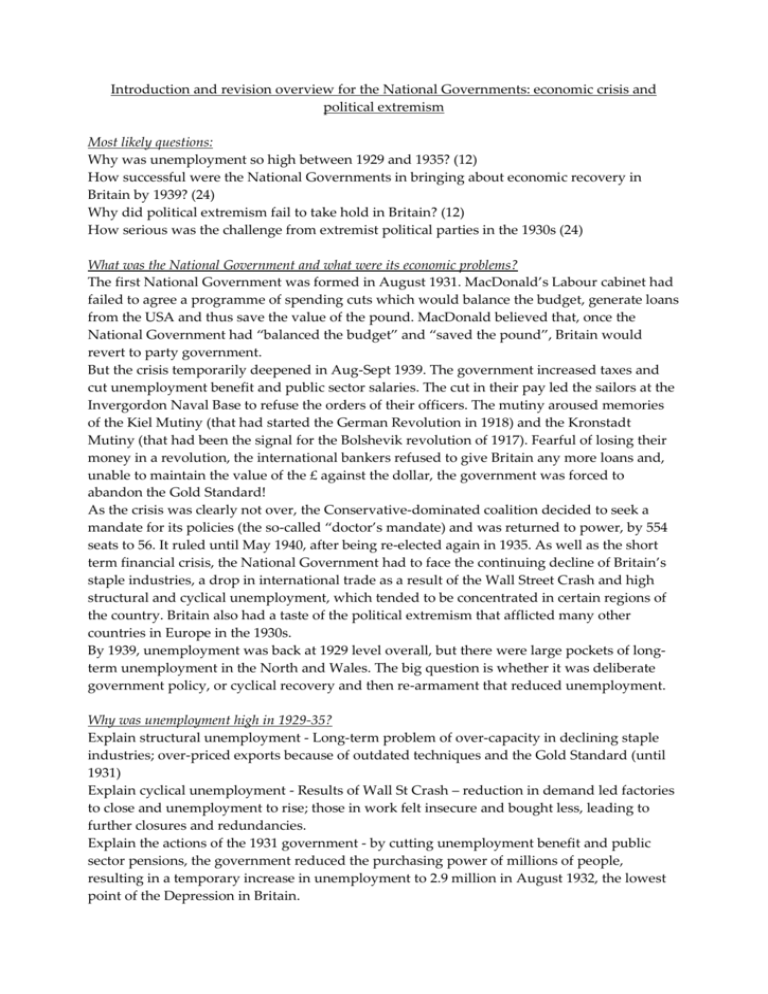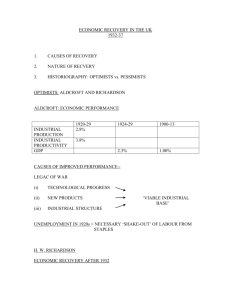Introduction and revision overview for the National Governments
advertisement

Introduction and revision overview for the National Governments: economic crisis and political extremism Most likely questions: Why was unemployment so high between 1929 and 1935? (12) How successful were the National Governments in bringing about economic recovery in Britain by 1939? (24) Why did political extremism fail to take hold in Britain? (12) How serious was the challenge from extremist political parties in the 1930s (24) What was the National Government and what were its economic problems? The first National Government was formed in August 1931. MacDonald’s Labour cabinet had failed to agree a programme of spending cuts which would balance the budget, generate loans from the USA and thus save the value of the pound. MacDonald believed that, once the National Government had “balanced the budget” and “saved the pound”, Britain would revert to party government. But the crisis temporarily deepened in Aug-Sept 1939. The government increased taxes and cut unemployment benefit and public sector salaries. The cut in their pay led the sailors at the Invergordon Naval Base to refuse the orders of their officers. The mutiny aroused memories of the Kiel Mutiny (that had started the German Revolution in 1918) and the Kronstadt Mutiny (that had been the signal for the Bolshevik revolution of 1917). Fearful of losing their money in a revolution, the international bankers refused to give Britain any more loans and, unable to maintain the value of the £ against the dollar, the government was forced to abandon the Gold Standard! As the crisis was clearly not over, the Conservative-dominated coalition decided to seek a mandate for its policies (the so-called “doctor’s mandate) and was returned to power, by 554 seats to 56. It ruled until May 1940, after being re-elected again in 1935. As well as the short term financial crisis, the National Government had to face the continuing decline of Britain’s staple industries, a drop in international trade as a result of the Wall Street Crash and high structural and cyclical unemployment, which tended to be concentrated in certain regions of the country. Britain also had a taste of the political extremism that afflicted many other countries in Europe in the 1930s. By 1939, unemployment was back at 1929 level overall, but there were large pockets of longterm unemployment in the North and Wales. The big question is whether it was deliberate government policy, or cyclical recovery and then re-armament that reduced unemployment. Why was unemployment high in 1929-35? Explain structural unemployment - Long-term problem of over-capacity in declining staple industries; over-priced exports because of outdated techniques and the Gold Standard (until 1931) Explain cyclical unemployment - Results of Wall St Crash – reduction in demand led factories to close and unemployment to rise; those in work felt insecure and bought less, leading to further closures and redundancies. Explain the actions of the 1931 government - by cutting unemployment benefit and public sector pensions, the government reduced the purchasing power of millions of people, resulting in a temporary increase in unemployment to 2.9 million in August 1932, the lowest point of the Depression in Britain. What factors improved the situation by 1939? Government policies o It passed the Import Duties Act, 1932, placing tariffs on imports from countries outside the British Empire. o It tried to set up an “imperial preference” trading network within the British Empire whereby the dominions accepted British goods in preference to those from countries such as the USA and vice versa. The success of the Ottawa Conference, 1932, was limited, however, because countries like Canada and South Africa were trying to develop their own industries and didn’t want to give preference to British goods. o It passed Special Areas Acts, giving small amounts of investment to the depressed staple industries in return for the closure of the least profitable textile mills, ship yards etc. o It guaranteed prices and offered subsidies to farmers. o It borrowed £1,500 million after 1935, in order to rearm. o It granted monopolies to new industries to help them develop without competition e.g. the British Overseas Aircraft Corporation (BOAC = BA) Factors not the direct result of government policy o Low interest rates and therefore cheap mortgages stimulated private house building and all the related industries e.g. furniture manufacture, motor vehicle manufacture, white goods o Low interest rates enabled manufacturers to invest in new industries in Midlands and London area How far did the situation improve? The figures here show that overall unemployment decreased, but that regional long-term unemployment in the staple industries remained high, even after the government began a serious rearmament drive. a) Total unemployment: b) % of workers unemployed, by region, in 1936 1927 = 1.1m SE England 5.6% 1928 = 1.3m London 6.5% 1929 = 1.2m SW England 7.8% 1930 = 1.9m Midlands 9.4% 1931 = 2.7m 1932 = 2.8m 1933 = 2.5m NW England 16.2% 1934 = 2.1m NE England 16.6% 1935 = 2.0m Scotland 18% 1936 = 1.7m N. Ireland 23% 1938 =1.9m Wales 28.5% 1939 = 1.25 1941 = less than 1 m c) % of unemployed who had been unemployed for over a year Sept 1929 – less than 5% of the 1.2 million unemployed people i.e. fewer than 60,000 Aug 1932 – 16.4% of the 2..9 million unemployed people i.e. more than 400,000 Aug 1939 – 19.5% of the 1.25 million unemployed people i.e. 244,000 How successful was the National Government in bringing about economic recovery in the 1930s? Introduction: Context (what was the NG), debate (were problems solved and should gov’t take the credit) and argument you will put forward (are you orthodox or Keynesian??) Development: Government policies that had some success: o The first National Government under MacDonald made the spending cuts that restored financial confidence o It made the decision to take sterling off the Gold Standard, which had several beneficial effects – cheaper exports and low interest rates o It took several measures to stimulate the staple industries – import tariffs, rationalisation agreements, the Special Areas Acts o It protected British farming o It gave monopolies to several new industries o It borrowed money to enable rearmament Government policies that had limited or unintended success: o The first National Government’s spending cuts reassured international financiers but, by reducing millions of people’s spending power, they increased unemployment o The government did not choose or want to leave the Gold Standard, so cannot really take the credit for low interest rates or cheaper exports o The measures to stimulate the staple industries were too little; the government believed that people should move to areas where there were jobs, rather than being committed to job creation o Import tariffs, whilst protecting British industries, led to retaliatory tariffs from other countries. Thus British industries had to rely heavily on the home market (UK consumers) o Rearmament, a necessity not a choice, may have been the government’s most effective policy Factors other than government policy that helped recovery: o The employed majority benefited from low prices and low interest rates and, by buying homes and goods, helped the home market revive o Because of effective contraception, family sizes were decreasing, leading people to have money for all kinds of “extras” such as entertainment and holidays – helped transport, tourism, leisure industries o Entrepreneurs were developing new industries based on electricity, chemicals, aircraft, motor vehicles o German foreign policy forced rearmament on Britain o The world gradually recovered from the cyclical slump, Britain included Conclusion: The National Government’s largely orthodox policies helped create a climate of stability that helped cyclical recovery, after the trauma of 1929-31. But they were marginal in terms of cutting unemployment, especially in the staple industries. The main factor in reducing unemployment (and it didn’t entirely recover) was rearmament. How serious was the threat posed by political extremism and why did it fail? See Mr Panter’s pp on Moodle









